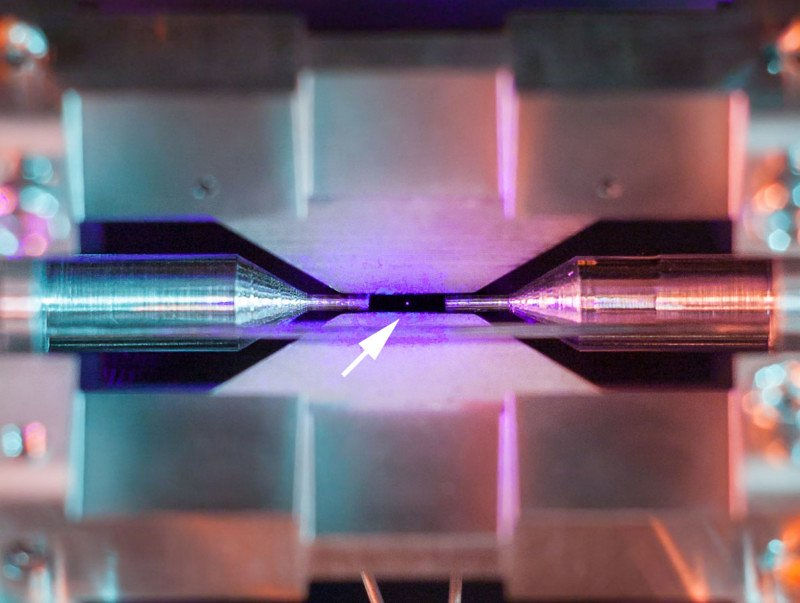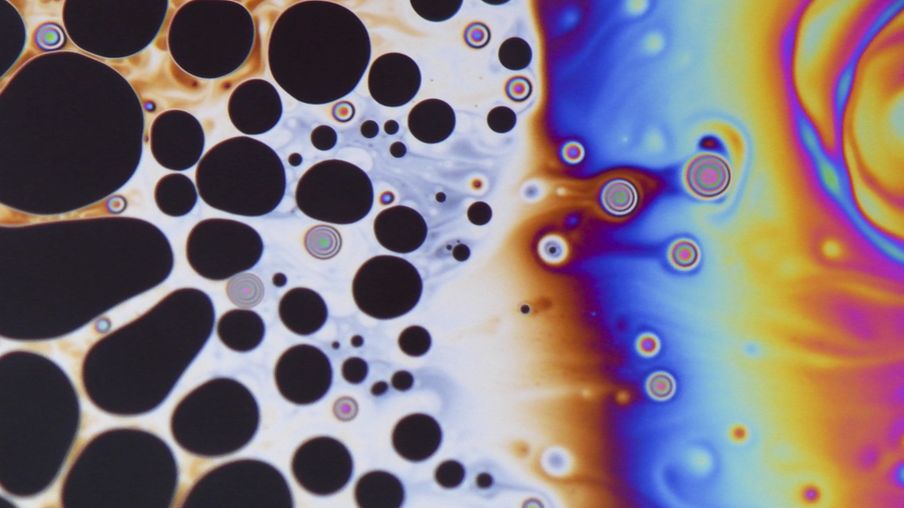Photograph of the strontium atom in the ion trap won the competition of scientific photography

"One atom trapped." Competitive work by David Nadlinger of Oxford University. In the photo of the original size, you can see the bright point in the middle of the trap. This is an atom of strontium, re-emitting photons with laser illumination. Photo: David Nadlinger / University of Oxford / EPSRC Photography Competition 2017
The photo of a positively charged strontium atom trapped in fixed electric fields won the fifth annual scientific photography competition organized by the Research Council of Engineering and Physical Sciences of Great Britain (EPSRC).
The beauty of this photo is that one atom is photographed by a conventional digital camera. When illuminated by a blue-violet laser, the atom absorbs and re-emits the photons of light fast enough so that an ordinary camera can fix it at long exposures. The electric fields of the trap are generated by metal electrodes. The distance between them in the photo is two millimeters.
Laser-cooled atomic ions provide an ideal platform for studying the unique properties of quantum physics. They also serve as extremely accurate atomic clocks and sensors. Perhaps in the future they will be used in quantum computers, which are an order of magnitude superior to the performance of modern supercomputers in certain types of tasks.
')
The picture was taken through the window of the ultra-high vacuum chamber, in which the ion trap is located. Photo by David Nadlinger of Oxford University.
“I was struck by the idea that the atom is visible to the naked eye,” says the scientist and author of the photo. “It represents a wonderful, direct and intuitive relationship between the miniature quantum world and our macroscopic reality.” A quick calculation on a napkin showed that the numbers were on my side, and one quiet Sunday I went to the laboratory with a camera and tripods - and was rewarded with this particular photo with a small pale blue dot . ”

The competition was held in five categories, in each of which three winners were determined. The work of David Nadlinger took the top prize and the 1st place in the category “Equipment and Apparatus”. Below are the winners in the remaining categories.
Eureka and discoveries

Photo: Li Shen / Imperial College London / EPSRC Photography Competition 2017
Photograph of the pattern that forms on the lather in the kitchen sink. The two multi-colored parts of the image demonstrate the physical phenomenon of the formation and behavior of bubbles in substrates like washing liquids and carbonated drinks. The picture shows how the process of bubble burst begins, when the two parts of the foam begin to penetrate each other. The photo is called “In the kitchen far, far away” (In a Kitchen Far, Far Away), which resembles the first phrase in the liner to the space opera “Star Wars”. Written by Li Shen of Imperial College London.
Innovation

Photo: Estelle Beguin / University of Oxford / EPSRC Photography Competition 2017
“Microbubble for drug delivery” - the work of Estelle Beguin from the University of Oxford, who won in the “Innovations” category. Such microbubbles consist of gas and a biocompatible shell. They are used to enhance the contrast of ultrasound diagnostic images. The possibility of their use for therapeutic purposes and for accurate drug delivery to certain parts of the human body, for example, to cancer tumors, is being studied. The image from the microscope shows a micron-sized vial coated with liposomes containing the preparation. Liposomes have nanometer size. The length of the scale on the photograph is 2 microns, that is, the diameter of the entire bubble is approximately 5 microns. The drug delivery system includes the controlled transportation and release of a drug at a specific location.
People and abilities

Photo: Mr Richard Coyne / University of Edinburgh / EPSRC Photography Competition 2017
The photo titled “Spiderman on the George the Fourth Bridge” was taken by scientists from the University of Edinburgh during a mobile electroencephalograph (EEG) trial. A volunteer named Spiderman is one of 95 experiment participants over the age of 65 who studied the brain's response to various types of urban environments: from highways to quiet parks. According to the results of the experiment, scientists have found that a different urban environment causes a different emotional response in a person. This can be used in urban planning for more thoughtful urban planning.
Strange and beautiful

Photo: Bernice Akpinar / Imperial College London / EPSRC Photography Competition 2017
“A natural nanoscale network for capturing color” - the work of Bernice Akpinar from Imperial College London. The photograph of an atomic force microscope captured a fragment of butterfly wings. They are covered with a nanometer structure to reflect the sun color at different wavelengths. Because of this effect in the visible range, it seems that the wings of the butterfly shimmer in different colors.
Photos of the other winners can be found here .
Source: https://habr.com/ru/post/371261/
All Articles